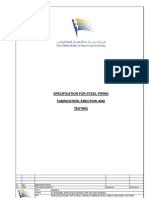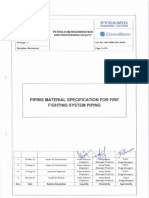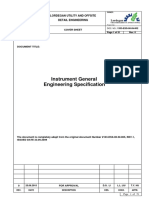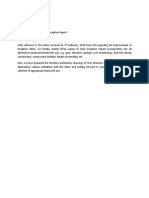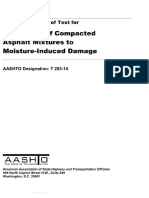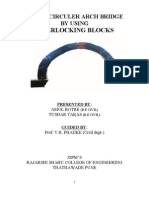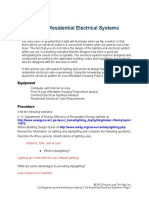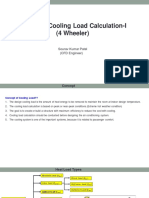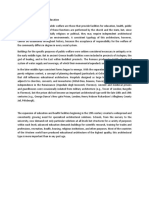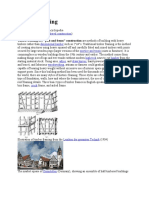Design Basis Memorandum - Mechanical Equipment and Systems
Design Basis Memorandum - Mechanical Equipment and Systems
Uploaded by
Luojisi CilCopyright:
Available Formats
Design Basis Memorandum - Mechanical Equipment and Systems
Design Basis Memorandum - Mechanical Equipment and Systems
Uploaded by
Luojisi CilOriginal Description:
Original Title
Copyright
Available Formats
Share this document
Did you find this document useful?
Is this content inappropriate?
Copyright:
Available Formats
Design Basis Memorandum - Mechanical Equipment and Systems
Design Basis Memorandum - Mechanical Equipment and Systems
Uploaded by
Luojisi CilCopyright:
Available Formats
Kali Gandaki "A" Hydroelectric Project Nepal Electricity Authority
DOCUMENT 4190-02-6010
DESIGN BASIS MEMORANDUM - MECHANICAL EQUIPMENT
AND SYSTEMS
CONTENTS
1. OBJECTIVE
2. SCOPE
3. GENERAL GUIDELINES
4. TURBINES
5. GOVERNORS
6. INLET VALVES
7. BRIDGE CRANES
8. COOLING WATER SYSTEM
9. DRAINAGE SYSTEM
10. DEWATERING SYSTEM
11. MECHANICAL WORKSHOP EQUIPMENT
12. FIRE FIGHTING EQUIPMENT
13. VENTILATION SYSTEMS FOR POWERHOUSE AND
INTAKE SERVICE BUILDING
14. STATION SERVICE AIR SYSTEM
15. STATION SERVICE WATER SYSTEM
16. UNIT FILL SYSTEM
17. OIL HANDLING SYSTEM
18 DIFFERENTIAL PRESSURE TYPE FLOW METERING
SYSTEM
19. ELEVATOR
20. PLUMBING SYSTEM
1. OBJECTIVE
This memorandum provides the basic information, standards and guidelines for the
preparation of contract documents for the procurement and installation of hydraulic
turbines, governors, turbine shut-off valves and auxiliary mechanical equipment for the Kali
Gandaki "A" powerhouse. This document should also be read with reference to the General
Design Memorandum.
Rev. Revisions Submitted Approved Issue Date
No. Proj.Engr. Proj.Mgr.
0 Original Issue JT OH 31 Dec 93
1 Revised for Surface PH JT Jan 97
2 Final Update PM, BKP CPH Jan 02
Morrison Knudsen International, Inc. Page 1 of 26 DBM - Final Update
Kali Gandaki "A" Hydroelectric Project Nepal Electricity Authority
2. SCOPE
Complete contract documents will be prepared for the design, manufacture, shop testing,
transporting to site, erection and commissioning of the mechanical equipment described in
this document.
3. GENERAL GUIDELINES
3.1 Standards and Codes
In addition to standards listed in GDM, the following standards will be referred to in the
Mechanical Equipment Specification:
o NFPA National Fire Protection Association, USA
o ANSI American National Standard Institute, USA
o IEEE Institute of Electrical and Electronic Engineers, USA
o SMACNA Sheet Metal and Air Conditioning Contractors' National
Association, Inc., USA
o ASHRAE American Society of Heating, Refrigerating and Air
Conditioning Engineers, Inc., USA
o ARI Air Conditioning and Refrigeration Institute, USA
o ASTM American Society for Testing and Materials, USA
o ASME American Society of Mechanical Engineers, USA
o AWS American Welding Society, USA
3.2 Materials
All materials incorporated in the equipment supplied will be of quality, grades and
conditions as set forth in the approved standards.
Materials shall be suitable for their purpose and shall as far as practicable comply with the
latest issue or revision of the following standards or their approved equivalent. Materials
not specifically designated herein will be subject to the Engineer's approval. The use of
alternative materials having corresponding or higher quality and properties will be subject to
the approval of the Engineer.
Materials for general purposes shall have a quality equal to, or better than, the following:
Cast steel for general engineering ASTM A27, Grade 65-35
purposes DIN 1681, GS 45.3, W1.0466, JIS G 5101
Iron castings, grey ASTM A278, Class 35
DIN 1691 GG 25
Iron castings, nodular ASTM A536
DIN 1693, GGG 40, W1.7040
Steel forging for generator rotors ASTM A469, Class 1
Morrison Knudsen International, Inc. Page 2 of 26 DBM - Final Update
Kali Gandaki "A" Hydroelectric Project Nepal Electricity Authority
Flanged joints DIN, Subject Groups: 2810, 2820, 2850, 2870,
2880
Structural steel, general ASTM A36
DIN-EN 10025, Fe 360 C.
Structural steel, weldable fine-grained DIN 17102, DIN-EN 10025, Fe 510 D1
Bronze castings ASTM B584, Alloy 2B
DIN 1705, RG 7
Bronze for bearings, bushings thrust ASTM B584, Alloy 3A
discs, etc. DIN 1716, SNPBBZ 10
Welded and seamless steel piping ASTM A53, Grade A
DIN 1626, 1628, 1629, 1630
Stainless steel piping ASTM A269, Grade Type 304l
DIN 17440, W 1.4301
Stainless steel plates ASTM A240, A314 - TP 304l
DIN 17440, W1.4301
Stainless steel castings ASTM A487, DIN 17445
Babbitt metal for bearings ASTM B23, Grade 3 DIN 1703
Turbine shaft steel strength ASTM A668, Class D
DIN 17200, Impact (0oC) > 22 J.
3.3 Allowable Stresses
Ample factors of safety shall be used throughout the design of the equipment, especially in
the design of parts and components subject to alternating stresses, vibration, impact or
shock.
Under maximum design conditions and hydrostatic pressure test conditions respectively, the
stress levels in the material shall not exceed the following values unless otherwise stated by
the manufacturer and approved by the Engineer.
Cast steel, general maximum static stress 35% of the yield strength
level
Cast steel, maximum static stress at points 45% of the yield strength provided
with local stress concentrations calculated that the quality of material can be
according to methods approved by the controlled by approved methods at
Engineer the points with stress concentration
Cast iron 20 N/mm2, max. tensile stress
Morrison Knudsen International, Inc. Page 3 of 26 DBM - Final Update
Kali Gandaki "A" Hydroelectric Project Nepal Electricity Authority
65 N/mm2, max. compressive stress
Structural steel materials 50% of the yield strength
General maximum static stress
Structural steel materials 60% of the yield strength provided
Maximum static stress at points with local that the quality of material can be
stress concentrations calculated according controlled by approved methods at
to methods approved by the Engineer the point with stress concentration
Components under hydrostatic pressure 80% of the yield strength (during
testing tests)
Rotating parts under maximum runway 67% of the minimum yield strength
conditions
For other materials the maximum stress in tension or compression will not exceed one-third
of the yield strength or one-fifth of the ultimate strength of the material.
Maximum shear stresses shall not exceed 60% of the allowable stresses in tension, except
that the combined longitudinal, bending and maximum torsional shear stresses in the main
turbine and generator shafts shall not exceed 40 N/mm2.
The yield strength shall be deemed to mean the guaranteed, minimum yield strength.
Materials not having a defined yield point shall not be permitted to be used in the
equipment.
All components shall be designed for a lifetime of 50 years under normal running
conditions. Due consideration shall be made to dynamic stresses, which shall be kept within
the stress limits stated above. The effects of corrosion, stress concentrations, notches, etc.,
will be duly considered.
3.4 Design and Calculation Standards
All piping will be of carbon steel, stainless steel, 18.8 CrNi or better. Except from the supply
pipe from penstock to ejector-pump, which will be PN 16 quality, valves, etc., shall at least
be of standard PN 6 quality.
Flanges, valves and fittings for auxiliary systems will be classified according to their
nominal diameter, DN, and nominal pressure, PN.
Stainless steel pipes shall have a minimum wall thickness of 1% of the outer diameter, but
not less than 2.0 mm.
The danger of galvanic corrosion and/or induced electric currents in the pipe systems will be
considered, the necessary isolating flanges shall be provided and the ranking order of
different materials taken into account.
All required piping will be furnished complete with flanges, unions, expansion joints,
gaskets, packing, valves, drains, vents, pipe hangers, supports, etc.
Morrison Knudsen International, Inc. Page 4 of 26 DBM - Final Update
Kali Gandaki "A" Hydroelectric Project Nepal Electricity Authority
All welding of stainless steel will be carried out using the inert gas method (TIG/MIG).
Pipes shall be locally filled with inert gas during welding.
Pipes located within the powerhouse carrying cold water will be insulated to avoid
condensation.
Metric (DIN) flanges shall be used throughout. Flanges shall be of the weld neck or slip-on
type flanges. The raised face shall be machined. Flange bolts and nuts shall in general be of
stainless steel.
Valves shall have nodular cast-iron valve bodies of a quality not less than GGG-40
according to DIN 1693.
Generally, all isolating valves shall be gate valves, preferably of the free-flow, gate
rubber-lined, body epoxy-lined type. Other types will be the ball type for small dimensions
such as manometer isolating valves. Valves shall be leak-proof in either flow direction at
any pressure less than the nominal pressure.
Non-return valves (check-valves) shall be of non-shock, low-resistance type and subject to
the Engineer's approval.
Strainers etc. shall be of a corrosion-proof material or protected by means of hot-dip
galvanizing and proper painting if specified.
All associated hangers, bolts and nuts shall be of stainless steel or hot-dip galvanized steel.
All pumps to be supplied for the works shall be of a reputable make and of a type best suited
for their purpose. They shall be furnished complete with electrically driven motors of ample
capacity to provide safe and continuous service under all operating conditions of the
respective system.
For submersible pumps, pump and motor shall be contained in the same casing and
designed as a package unit with incorporated suction strainer.
For any pump, the overall pump/motor efficiency for the specified rated head and discharge
shall not be less than 60%.
3.5 Quality Assurance
The Contractor will be required to perform all material, mechanical and/or electrical
assembly, dimensional and operational tests as required to confirm that the equipment meets
all requirements of the contract documents and of applicable codes, standards and
regulations. The Engineer or an authorized testing agency will witness certain tests and
inspect critical parts and assemblies during various stages of manufacturing and erection.
The contract documents will identify those parts, assemblies, and tests which require
inspection.
Morrison Knudsen International, Inc. Page 5 of 26 DBM - Final Update
Kali Gandaki "A" Hydroelectric Project Nepal Electricity Authority
3.6 Bidder Qualification
Turbine, governor and shut-off valve bidders will be required to demonstrate that they have
designed, manufactured, and put in successful operation at least one Francis turbine
installation of approximately the same capacity and turbine operating head of about 115 m
during the last 10 years. The Tenderers shall also in their Tenders demonstrate that they
fulfill specified quality assurance requirements.
4. TURBINES
4.1 Design Parameters
The total power plant rated net output will be 144 MW. Each of the three identical Francis
turbines will be rated 48 MW.
Turbine main data will be as follows:
o Number of units : 3
o Type of turbines : Francis
o Rated turbine output : 48 MW
o Design net head : 115 m
o Nominal rotating speed : 300 rpm
o Maximum runaway speed : 600 rpm (approx.)
o Turbine setting : El. 389.50 (Centerline of Spiral case)
The Tenderer will be requested to give efficiency guarantees as well as guarantees against
noise, vibration and cavitation for continuous operation down to 50% of full load within the
actual range of heads.
4.2 Headwater Levels
The turbines will operate under a headwater level regulated between El. 524 and El. 518.
During extreme floods, the headwater level may reach El. 532.32 (PMF).
4.3 Tailwater Levels
Minimum tailwater level is taken to be at El. 392.0 corresponding to the minimum river
flow of approximately 10 m3/s and all units out of operation. Assuming one unit operating at
half load as the absolute minimum operating condition, the minimum tailwater level will be
at elevation 393. Minimum tailwater level with only one unit operating at full capacity will
be at El. 393.5.
Maximum tailwater level during operation is limited to El. 409.3. At PMF (Probable
Maximum Flood), the tailwater level will reach El. 413. At this level, the stresses indicated
above shall not exceed 90% of the material yield strength.
4.4 Turbine Setting
Critical condition for the cavitation and governing for the turbine settings will be the
tailwater level when one unit is operating at full load. The minimum tailwater level will
Morrison Knudsen International, Inc. Page 6 of 26 DBM - Final Update
Kali Gandaki "A" Hydroelectric Project Nepal Electricity Authority
then be at El. 393.5. Due to expected sand abrasion, the turbine setting shall under all
circumstances be established conservatively to avoid accelerated cavitation resulting from
sand abrasion. The centerline of the turbine spiral casing will be kept at El. 389.5.
4.5 Heads and Losses
According to the water levels given above, the gross head will vary between 111 and 131 m
when the plant is in operation. Calculations carried out during plant optimization (Project
Formulation Report I) indicates a weighted mean net head of 115 m which will be the
design net head of the turbines. The total headloss at full load operation of all units is
approximately 7.0mWC. The maximum turbine output with only one unit in operation at
full gate and at maximum gross head, will be approximately 48.83 MW.
4.6 Transients
4.6.1 Headrace Surge Tank
The surge tank is of the differential type with a throttled inlet to the main tank at elevation
495. The main tank water surface area is approximately 500 m 2. The cross section of the
riser is about 35 m2 and the throttle area is 4.9 m2 at the bottom of the 2m high, inverted
cone type orifice.
Maximum up- and downsurge are calculated and basis for the calculations is as follows:
o Highest operating reservoir level El. 524
o Lowest operating reservoir level El. 518
o Headrace tunnel:
length 6000 m
cross section 43 m2 (dia. 7.4 m)
Manning number 0.014
Highest upsurge will theoretically reach about El. 540. The maximum upsurge is calculated
for a case with simultaneous load acceptance from 50% gate to full load followed by
simultaneous load rejection on all units at the most unfavorable moment.
Lowest downsurge will reach elevation 510 approximately. The lowest downsurge is
calculated for a case with simultaneous load acceptance for all units.
4.6.2 Tailrace Surges
Separate draft tubes will lead from each turbine to the tailrace.
Basis for the calculation of maximum up tailwater surges and downsurges is as follows:
o Highest operating tailwater level El. 409.30
o Lowest operating tailwater level
when one unit operates at full load El. 393.50
o Draft Tube
length along centerline 17.00 m
cross section at outlet 17.974 m2
Morrison Knudsen International, Inc. Page 7 of 26 DBM - Final Update
Kali Gandaki "A" Hydroelectric Project Nepal Electricity Authority
Manning number
- steel lining 0.012
- concrete lining 0.014
At highest operating level, maximum tailwater upsurge at full load acceptance will reach
elevation 409.4.
Lowest tailwater downsurge caused by a full load rejection will reach El. 392.
4.6.3 Speed and Pressure Rise
The maximum pressure rise during load rejection (simultaneous shutdown of all units from
any gate position) will be limited to 23.5% of rated head.
The corresponding speed rise is tentatively calculated to be maximum 50% of rated speed.
Basis for the calculations is as follows:
o Headrace tunnel and surge shaft As described above
o Penstock length excl. manifold & pressure shaft 230 m (approx.)
o Penstock diameter 5250 mm
o Manifold See Drawings
o Generator moment of inertia (GD2) 1700 tm2
4.6.4 Frequency Stability
The Kali Gandaki "A" power plant shall be capable to regulate the frequency when
operating alone at full load on a separate electrical network.
Calculations have been carried out using a traditional frequency analysis method. Pure
resistive load have been assumed. Waterways, surge chamber and generator and turbine data
are as described above.
According to the Bode-Nyquist criterion, the stability margins are as follows:
o Phase margin 32o
o Gain margin 5 dB
The temporary frequency drop resulting from a load acceptance of 10% of full load will be
approximately 3 Hz.
Calculations also show that the suggested surge tank water surface area (530m2) can be
considered as a minimum (Thoma criterion).
4.7 Design Pressure
The design pressure for turbines and inlet valves shall be limited to 160mWC corresponding
to approximately 115% of maximum static head at highest operating headwater level, El.
524.00
Morrison Knudsen International, Inc. Page 8 of 26 DBM - Final Update
Kali Gandaki "A" Hydroelectric Project Nepal Electricity Authority
4.8 Speed of Rotation
The speed of 300 rpm is chosen as a compromise between the economic benefit of high
speed, and the hydraulic and mechanical technical considerations which limit the speed, but
it is still on the conservative side for sand abrasion.
4.9 Efficiency
The peak efficiency point (the output where the turbine has its best efficiency) is specified to
be at approximately 90-95% of maximum output. Some tolerance is allowed for in order to
adapt to the manufacturers' existing model turbines.
4.10 Efficiency and Cavitation Tests
Efficiency guarantees will be given by the manufacturer based on model tests of a
homologous turbine model. Cavitational performance as well as hydraulic load, runaway
speed, guide vane torque, etc., shall be documented through these model tests. A separate
model of the Kali Gandaki "A" turbines shall be designed and tested in the manufacturer's
laboratory.
Instruments and provisions for relative efficiency tests (Index tests) shall be included in the
supply and measurements shall be performed during commissioning.
4.11 Turbine Design and Materials
The three Francis turbines will be of modern, but well proven design which can be offered
from the most recognized manufacturers.
The turbine design will be as follows:
o The steel structures of the spiral casing, covers, stay ring, draft tube, etc., will be
made from fine grained, carbon steel according to approved standards. Stainless
steel will be used for guide vanes, surface lining on upper and lower covers (guards
rings), and also for most bolts, auxiliary piping etc.
o The runner will be a cast or welded construction of 13% chrome, 4% nickel steel,
alternatively 16/5 CrNi.
o The turbine shaft will be forged mild steel with integrally forged flanges.
o The turbine bearing will be designed as a guide bearing with removable segments
with bearing metal. The entire thrust from rotating parts and the hydraulic load shall
be taken by the upper generator thrust bearing. The bearing oil circulation will be
activated by the rotation of the shaft. The cooling will be by means of at least two
external oil-to-water heat exchangers, one as a permanent stand-by.
o The wicket gates will be operated by two servomotors, pressurized by the
accumulator of the governor oil pressure system. The gate position is mechanical
Morrison Knudsen International, Inc. Page 9 of 26 DBM - Final Update
Kali Gandaki "A" Hydroelectric Project Nepal Electricity Authority
feedback from the distributing valve or as an electrical signal to the governor
cubicle.
o Wicket gate shafts and all moving parts of the operating mechanism will, as a main
alternative, run in self-lubricating long life bushings. Gate shaft bushings shall be
protected against sand intrusion.
o All non-mating ferrous surfaces will be coated with a two-component epoxy paint.
Due to the extreme concentration of suspended abrasive sand in the water, sand erosion on
turbine runner, wicket gates cover face, labyrinth seals, etc., is likely to occur. Some special
features will therefore be required to reduce erosion as well as to facilitate for easy
accessibility and replacement of turbine parts exposed to erosion:
o Exchangeable facing wear plates (guard rings) in stainless steel will be provided
above and below the wicket gates.
o To protect the shaft seal against sand erosion, the seal shall be of a type where
pressurized filtrated lubricating water is supplied. Lubricating seal water will be
supplied from two decanting gravity tanks located at the powerhouse cooling water
tank room. Piping from the tanks to the turbines will be part of the supply.
Alternatively the turbine may be of a design preventing unclean water entering the
sealbox during operation. A simple labyrinth seal may then be provided, combined
with a standstill seal which is automatically activated as an integrated part of the
start/stop sequence of the respective generating unit.
o In order to reduce the expected sand abrasion problems the Tenderers will be
requested to offer, as an option, abrasion resistant coating or other surface treatment
systems applied on turbine runners, seal rings, guide vanes and cover face plates.
Various systems exist, and the Tenderers offering such an abrasion protection system
shall in their tenders provide necessary references and documentation for the
proposed system. Only well-documented protection systems will be considered.
o To avoid removing the generator rotor during replacement of runner, labyrinth seal,
etc., the design shall allow the turbine runner to be removed by either of the
following two alternate procedures. The first procedure will remove the runner
downwards after having removed the draft tube cone through a recess in the turbine
foundation. The labyrinth seal rings, guide vanes, cover wear plates (guard rings)
and other vulnerable parts exposed to sand erosion will also be accessed and
removed downwards after having removed the runner. The second alternate
procedure will remove the runner upwards after having removed the turbine
intermediate shaft, the head cover, guide bearing and shaft-seal. The runner will be
hoisted up to the turbine pit and then moved out of the pit onto the turbine floor by a
wheeled cart.
o Runners and other turbine parts to be replaced or repaired as mentioned above can
be hoisted to the erection bay of the machine hall floor or to the plant deck through
hatchways in various floors. At each of the units, hatchways will be provided for
installation/removal of the inlet valves, head covers and runners.
Morrison Knudsen International, Inc. Page 10 of 26 DBM - Final Update
Kali Gandaki "A" Hydroelectric Project Nepal Electricity Authority
A relative large extent of spare parts will be specified due to expected sand abrasion. As a
basis the following quantities will be specified:
3 stainless steel turbine runners
3 sets of guide vanes
3 sets seal rings for upper and lower cover
3 sets of exchangeable facing wear plates (guard rings) for upper and lower bands
3 sets of shaft seal wear parts
In addition, the spare part supply will mainly comprise one complete turbine shaft bearing,
three links and levers for the operating mechanism, one complete servomotor, one complete
set of guide vane bearings for all units and bearings and bushings for the operating
mechanism.
The spare part supply will be specified as a separate item, and NEA will have the option to
reduce or increase the extent of the supply after receiving the tenders (the necessary extent
of spare parts may be influenced by the quality of the offered abrasion protection system).
5. GOVERNORS
Governors of the solid state, electro-hydraulic PID type is specified. The specification will
require the governor to be a designed and finished product of a manufacturer having an
established reputation for satisfactory and reliable service for the type of governor specified.
The governor shall be designed and tested in workshop to comply with specification and
appropriate standards.
Speed sensing, PID functions, parameter setting, speed and load setting, stroke limitation,
speed droop function, feed-backs, protection and monitoring functions, etc., will be
incorporated in the electronic cubicles placed at the turbine floor.
The oil sump, also containing the main and standby pumps and most hydraulic components
will be arranged close to the turbines.
The oil accumulators are arranged as separate units close to the turbines.
The accumulators are of the oil/air type with separate compressors, or as lately adopted by
many manufacturers, of the piston or bladder type with nitrogen. In the latter case 100 bar
working pressure will be allowed, otherwise the oil pressure will be limited to 60 bar.
The oil-pumps are of the continuous running gear or screw type, equipped with unloading
valves or alternatively of the variable displacement piston type.
To reduce the extent of the installation and the number of components, the turbine governor
oil system also supplies the operating mechanism of the inlet valve of the respective turbine.
Apart from minor components, one main oil pump with motor and one valve of each type
will be specified as spare parts.
Morrison Knudsen International, Inc. Page 11 of 26 DBM - Final Update
Kali Gandaki "A" Hydroelectric Project Nepal Electricity Authority
6. INLET VALVES
The turbine inlet valves will be of the butterfly type. The design pressure shall confirm with
the guaranteed maximum pressure during load rejection and will be approximately 160
mWC. The diameter shall be 2500 mm which will limit the maximum water velocity
through the valve to approx. 9.5 m/s thus eliminating any risk of vibration.
The valve disc will be equipped with one main and one maintenance seals. The maintenance
seal allows operation of the other turbines when adjusting or replacing the main seal of one
unit without unwatering the power tunnel. The maintenance seal is normally disengaged
when the valve is closed. Only when manually activated by water pressure from the
penstock the rubber seal will close and leave the main seal depressurized.
6.1 Valve Bypass and Actuator
The valves will be provided with a bypass line and a hydraulic servomotor actuator for
opening, both operated by oil pressure from the turbine governors. Counterweights will
close the valves. An orifice at the servomotor opening side will restrict the closing velocity.
Inlet cones upstream of the valves and expansion/dismantling joints between valves and
turbines will be included in the turbine/inlet valve supply together with all piping, draining
and other connections.
Apart from minor components such as bushings, rubber seals, gaskets, etc., one complete
valve servomotor will be specified as spare.
7. BRIDGE CRANES
7.1 Powerhouse Cranes
The powerhouse will be furnished with a set of two bridge cranes. Each bridge crane will
have a single trolley with a main hoist which shall serve any requirements for lifting and
moving of heavy components during installation, maintenance work and operation.
Additionally, each crane will be provided with an auxiliary hoist installed on the same
trolley. This will increase the crane operated area and offer quicker operation for smaller
components.
The main crane hook shall be capable to lift the tallest component off the transport vehicle
and both main and auxiliary hooks shall reach as far down as required to serve the draft tube
gallery at elevation 386.
Design parameters will be as follows:
o Main hoist capacity 80 tons
o Auxiliary hoist capacity 20 tons
o Bridge span (distance between rails) 10.30 m
o Lift (approx.) 20 m
The generator rotors are the heaviest components and the expected crane capacity will be
120 metric tons. The rotor lift will also determine the maximum lifting height above the
machine hall floor, estimated to be 9.0 m.
Morrison Knudsen International, Inc. Page 12 of 26 DBM - Final Update
Kali Gandaki "A" Hydroelectric Project Nepal Electricity Authority
The bridge, trolley and main and auxiliary hoist will be electric motor driven with power
being supplied to the bridge via conductors of the insulated rigid bar type.
The two 80-ton bridge cranes will be connected to a common 120-ton capacity lifting beam
to lift the assembled generator rotor which is expected to weigh 120 tons.
All the hatchways as well as the entire area of each generator top deck will be reached by
either the auxiliary hook or the main hook to hoist equipment through these hatchways.
Each of the powerhouse bridge cranes will have an operator's cabin which will be located at
the downstream side of the machine hall under the main girder. The cabin shall be equipped
with all necessary controls. Additionally, the cranes will have a controller pendant for use
from the machine hall floor. Access to the cabin will be arranged from the Office Floor at
El. 408.50.
In addition to minor parts, one electrical motor of each type will be specified as spare.
7.2 Plant Deck El. 413 Floor Bridge Crane
The plant deck floor located upstream of the switchyard will be provided with a bridge
crane to handle loading and unloading of equipment during erection and later maintenance
works.
Design parameters will be as follows:
o Main hoist capacity 40 tons
o Auxiliary hoist capacity 10 tons
o Bridge span (distance between rails) 11.54 m
o Lift (approx.) 32.4 m
Operator's cabin, controls and spare parts will be as for the powerhouse cranes.
7.3 Machine Shop Crane
The machine shop will be furnished with an underhung single girder type, electrically
operated crane complete with trolley and hoist.
The crane will have a rated capacity of 2 tons, and will have motorized bridge and trolley.
The crane bridge will be a heavy section structural beam. The trolley wheels will ride the
lower flange of the beam.
All crane motions will be controlled from a pendant with fail-safe pushbuttons that stop
crane motion (travel or hoisting) in the event that personnel utilizing the crane become
incapacitated.
7.4 Design and Calculation Standards
Morrison Knudsen International, Inc. Page 13 of 26 DBM - Final Update
Kali Gandaki "A" Hydroelectric Project Nepal Electricity Authority
Generally, for the design, stress calculation, manufacture and installation, the following
standards and codes, shall be applied:
Fédération Européenne de la Manutention (FEM)
• Section I : Rules for the Design of Hoisting Appliances (steel
structures and mechanisms)
• Section IX: Rules for the Design of Serial Lifting Equipment
(Mechanisms)
The lifting equipment shall be classified to FEM or DIN as follows:
• For lifting capacity up to and including 10 tons, group classification: 3
(structural)/2 m (mechanisms), representing an average daily working time
of 2 to 4 hours and an equal share of small, medium and heavy loads
(normal) duty.
• For lifting capacity larger than 100 kN (10 tons) group classification: 2
(structural)/1Bm (mechanisms), representing an average daily working time
of 1 to 2 hours and a small share of heavy load lifts (light duty).
Every lifting equipment will be subject to a test operation with an overload:
1.25 x nominal load for dynamic testing
The Contractor will be responsible for furnishing the test load and dynamometers.
The crane girders and runway tracks will be calculated for a deflection not exceeding 1:750
the span at maximum nominal load.
Steel structures of lifting equipment will be of welded construction, assembled at site. All
field connections and joints shall be bolted.
For lubrication, inspection and maintenance, ladders, platforms and stairs will be provided.
7.5 Material Standards for Cranes
The material to be used for manufacturing lifting equipment steel structures shall conform to
DIN-EN 10025 or to equivalent standards. However, the Contractor shall restrict the use of
structural steel to Fe 360 and Fe 510, minimum grade C. Fe 510 is preferred due to the
lower weight. Grades D1, D2, DD1 and DD2 can be demanded, depending among others on
the wall thickness, the testing of the material and the general stress levels.
The mean pressure exerted by the crane rails and their fixing elements upon the concrete
shall not exceed 10 N/mm2.
Morrison Knudsen International, Inc. Page 14 of 26 DBM - Final Update
Kali Gandaki "A" Hydroelectric Project Nepal Electricity Authority
7.6 General Design Particulars for Cranes
Hoists, trolley and bridge drives will be designed with equipment giving a smooth start and
stop.
Hoists, trolley and bridge drives will be equipped with adjustable brakes which is spring set
and electrically released. The braking action shall be smooth and gradual.
All wheels shall have double flanges and be made from cast steel. All bearings shall
preferably be of the self-lubricating type designed to permit easy shaft disassembly and easy
replacement.
Oil bath lubrication shall be provided for all high-speed gears and pinions. Low-speed gears
may be lubricated with soft grease. Suitable oil and grease catching drip pans shall be
installed and be readily accessible for draining and cleaning.
8. COOLING WATER SYSTEM
The cooling system shall serve all needs for cooling of the generating units.
8.1 System Description
The cooling water system will be designed as an open circuit system circulating clean water
in one pass through heat exchangers to generator air coolers, turbine and generator bearing
oil coolers. Each generating unit will be supplied with cooling water from separate water
pumping systems and desanding water tanks.
The cooling water will be taken from the tailrace and pumped up to a desander tank located
at the transformer deck. From the desander tank, water will flow to the shaft seal water
supply tanks as well as separately to the unit cooling water headers. The shaft seal water
supply tanks will furnish exclusively water for lubricating the shaft seal of the three
turbines.
The design of the cooling water system will provide redundancy to prevent unit stoppage
due to a failure of a cooling water system component, and to permit the
maintenance/replacement of pipe sections, valves, etc., while the system is in operation. For
these reasons, the design will include the following:
o Four centrifugal pumps, three unitized and one standby, installed inside the
powerhouse to pump tailrace water to the cooling water desander.
o Dual decanter chambers in the desander tank.
o Dual paralleled pipes from the cooling water pumping system to the
desander tank.
o Two parallel piping from the centrifugal pumps to the headers conveying
cooling water to the generating unit oil and air heat exchangers.
Morrison Knudsen International, Inc. Page 15 of 26 DBM - Final Update
Kali Gandaki "A" Hydroelectric Project Nepal Electricity Authority
o Two parallel piping systems each to convey water to a shaft seal water
supply header.
o Two parallel pipe headers to convey cooling water to the generating unit oil
heat exchangers.
To further guarantee that the turbine shaft seals will receive sediment-free seal water, the
turbines will be delivered with a pump and fine water filters to remove sediment from the
seal water. The cooling water supply lines from the centrifugal pumps will each be
furnished with a duplex coarse strainer and an automatic self-cleaning strainer. The piping
at these strainers will be so interconnected and valved that any of the strainers can serve
either of the two cooling water supply lines.
The cooling water discharge from air and oil heat exchangers from each generating unit will
discharge into the tailrace. Seal water from each turbine shaft seal will drain into the
dewatering sump of the respective unit. The cooling water supply tank will drain to the
tailrace; possible overflows will also drain to the tailrace.
8.2 Design Basis
It is estimated that the cooling water requirement will be as follows (per unit):
o Generator air coolers 20.8 l/s
o Generator bearing oil coolers 4.2 l/s
o Turbine guide bearing oil cooler 1.42 l/s
o Governor oil cooler 0.32 l/s
o Shaft Seal Water 1.0 l/s
________________________________________________________
o Total distribution circuit 27.7 l/s
It is assumed that maximum water temperature rise over the various coolers is 10oC.
With a maximum inlet temperature of primary water (river temperature) of 25oC, the
maximum temperature of water discharged from the unit heat exchangers will be 35oC.
One complete pump of each type with motor and one valve of each type will be included
among the spare parts in addition to gaskets and other wear parts.
8.3 Water Supply to Other Systems
The cooling water system will furnish desanded water from the desander tank to the
following systems:
System Supply l/s
Powerhouse Potable Water 5
Powerhouse Service Water 5
Morrison Knudsen International, Inc. Page 16 of 26 DBM - Final Update
Kali Gandaki "A" Hydroelectric Project Nepal Electricity Authority
Each of these systems will have its corresponding duplex booster pump complete with
pressure tank and controls.
9. DRAINAGE WATER SYSTEM
The powerhouse drainage system will be used for pumping to the powerhouse exterior the
following:
o Seepage face water from floors and corridors.
o Leakage from turbines.
o Backwash water discharge from self-cleaning water strainers.
o Condense water from air conditioning units and water chillers.
o Condense water from manifold.
These waters will be drained by gravity into the drainage sump, whence they will be
pumped to the tailrace.
The powerhouse drainage sump will be positioned close to the draft tube of Unit No 3.
Three submersible pumps, each with a capacity of approximately 30 l/s, will be installed.
The pump discharge pipes will be piped to a common pipe manifold. Water from the sump
will be pumped through the manifold to a pipe embedded in the powerhouse downstream
wall, and will discharge out at El. 412.
As an ultimate safety measure, one ejector-pump, driven by the penstock water pressure,
will also be installed in the sump. Capacity of the ejector will be approximately 40 l/s.
A control cabinet for pump operation will be installed at the turbine floor level, El. 390.50.
A sufficient number of level switches shall be installed in the sump for alarm and automatic
start and stop of the pumps. A level control in the drainage sump will control water supply
to the ejector-pump by hydraulic means, independent of AC electric power supply.
One complete pump with motor and one valve of each type will be included among the
spare parts in addition to gaskets and other wear parts.
10. TURBINE DEWATERING SYSTEM
Each generating unit will be provided with a separate system for dewatering of the
respective turbine. Embedded dewatering pipes will be lead from the lowest point of each
draft tube to sumps close to each draft tube. The sumps are equipped with submersible
pumps. The discharge pipe from each pump will discharge out to the tailrace at El. 412. The
capacity of the unwatering pump will be 30 l/s. A small drainage pump will be installed in
each sump for removal of draft tube gate leakage.
The amount of water to be removed will be equal to the content of the draft tube and spiral
casing as well as parts of the penstock located below tailwater level in cases when the
penstock shall be emptied. The penstock will be drained through one high pressure valve
located near the start of the manifold into Unit No. 1 dewatering sump.
Morrison Knudsen International, Inc. Page 17 of 26 DBM - Final Update
Kali Gandaki "A" Hydroelectric Project Nepal Electricity Authority
With a pump capacity of 30 l/s, it will take approximately 5 hours to empty the spiral casing
and draft tube. To empty the horizontal part of the penstock and the manifold, time required
will depend on the tailwater levels.
One complete pump with motor and one valve of each type will be included among the
spare parts in addition to gaskets and other wear parts.
11. MECHANICAL WORKSHOP EQUIPMENT
The mechanical workshop will be located on the service bay of the Machine Hall, El.
399.50.
The workshop will be equipped with necessary hand tools and engine tools for maintenance
and repair work including:
o One motor driven column drilling machine, floor type, maximum drilling capacity
approximately 30 mm in steel. The spindle head and the table shall be independently
moveable in the vertical and horizontal directions
o One two-wheel pedestal grinding machine, diameter of discs
250 - 300 mm
o One one-wheel pedestal roller-band grinding machine
o One pedestal mounted anvil, blacksmith type, standard shape
o One 230 by 900 mm bench lathe
o One portable welding transformer complete with all necessary leads, holders and 2
welding helmets. Electrode capacity max. 150 amp, 3.25 mm
o One welding transformer, wheel mounted, complete with all leads, holders and 2
welding helmets. Electrode capacity max. 400 amp, 6 mm
o One electrode storage cabinet with heating elements and temperature control
o One trolley mounted gas welding set, gas bottles for oxygen 401. 200 bar, acetylene
4001. 18 bar
o One welders table, 3 m long, with smoke hood
o One portable fan exhauster for site welding
o Two electric hand drilling machines, chuck to fit drill bit diameter up to 13 mm
o Two pneumatic drilling machines, chuck to fit drill bit diameter up to 13 mm
o Four pneumatic cleaning nozzles
o Two manual electric grinding machines, diameter of discs up to 220 mm
Morrison Knudsen International, Inc. Page 18 of 26 DBM - Final Update
Kali Gandaki "A" Hydroelectric Project Nepal Electricity Authority
o Two chain tackling blocks, manually operated and portable, capacity 1.5 tons, lifting
height 5 m
o Two chain tackling blocks, manually operated and portable, capacity 3 tons, lifting
height min. 3 m
o Two manually operated fork lift trolleys, capacity 2 tons
o One hydraulic jack, capacity 10 tons
o One plate shear, steel plate capacity 5 mm, steel bolt capacity 15 mm
o Two workbenches, length 2000 mm, width 800 mm, with storage shelves, drawers
and vices
o Four tool cabinets, steel cabinets for handtools, height 1000 mm, width 1000 mm,
depth 500 mm with suitable shelves, racks, clips and drawers
o One chest of drawers, steel drawers suitable for bolts, nuts, screws, etc., height 2000
mm, width 2000 mm and depth 700 mm
o Steel made racks, shelves and drawers suitable for the storage room next to the
workshop. Racks and shelves should be adjustable to fit different purposes, such as
storing lifting tackle, wire, ropes, boxes, crates, spare parts, tools, etc.
o Two vacuum cleaners, heavy duty, industrial type
o One air compressor unit for pneumatic tool supply, 8 bar, including pressure vessel,
guide couplings, flexible air hoses, etc.
o One sink, stainless steel
o One set of basic hand tools
The mechanical workshop will be furnished with a 2-ton underhung single girder crane,
complete with trolley and wire rope hoist. All of the crane motions will be pendant
controlled from the workshop floor.
Two roll-up doors, each 3 meters wide, will connect the workshop with the erection area.
12. FIRE FIGHTING EQUIPMENT
The transformer pits will be equipped with permanent fire fighting installations of the
deluge type supplied with water from a pipe tap on the penstock manifold. The system will
include all necessary equipment for fire detection and automatic activation.
Apart from this, all fire fighting equipment will be based upon portable fire extinguishers
placed at strategic positions all over the powerhouse, the intake service building, and the
Morrison Knudsen International, Inc. Page 19 of 26 DBM - Final Update
Kali Gandaki "A" Hydroelectric Project Nepal Electricity Authority
powerhouse bridge cranes. The extinguishers will be 4.5 kg and 23 kg units. The
extinguishing medium shall be classes A, B, and C dry chemical and CO2.
Smoke and fire dampers with operation controls, where used, will be incorporated in the
ventilation system.
The general alarm and fire detection system will be part of the electrical equipment supply.
13. VENTILATION AND AIR CONDITIONING
13.1 Powerhouse
The various floors and corridors of the powerhouse including the control room, visitors
room and SF6 equipment room will be provided with ventilation systems to dissipate
internal heat gains from equipment, to exhaust fumes and contaminated air to the plant
exterior, and to provide a safe and comfortable environment for personnel.
The powerhouse will in general be ventilated with filtrated air at a rate of 2 air changes per
hour during operation.
Air-conditioning will be provided in the following areas:
o Powerhouse control room
o Lobby, visitors room, lunch room first aid room, offices, kitchen, toilets and locker
rooms on the Office Floor of the powerhouse
o Electronic workshop and relays/communication room.
The ventilation air will be cooled before being distributed in air conditioning areas, by
flowing across chilled water coils. Water chillers will be installed in the powerhouse to
supply chilled water to cooling coils in air handling units serving the air conditioned areas.
Heating will be by duct-mounted electrical ductheater in the following areas:
o Powerhouse control room
o Offices and first aid room
o Cooling water pump area, elevator hall, access to draft tube Unit 3, on the Draft
Tube Floor of the powerhouse
o Turbine Floor of the powerhouse
o Spare parts storage rooms
o Corridor of Office Floor
The following condition and requirements will apply:
Morrison Knudsen International, Inc. Page 20 of 26 DBM - Final Update
Kali Gandaki "A" Hydroelectric Project Nepal Electricity Authority
Indoor condition:
o Design indoor temperature
in heated and air-cooled areas: 20 - 26C
o Design indoor temperature
in areas which will only be ventilated: 22 - 35C
o Design outdoor ambient temperatures will be taken as follows:
Summer: 36C db, 30C wb
Winter: 6C
Ventilation air to the powerhouse will be supplied through the powerhouse main ventilation
fan on the powerhouse roof. The air will be distributed to the various floors through a
metallic ductwork system.
Vitiated air from the following rooms will be exhausted to the powerhouse exterior by a
system of exhaust fans and ductwork:
Room Air Changes/
Hour
Lunch Room 3
Kitchen 8
Electronic Workshop 3
Mechanical Workshop 3
Toilet Rooms 12
Locker Rooms 12
Janitor Rooms 12
Sewage Ejector Room 12
Oil Room 12
Shaft Seal Water Tank Room 8
Shaft Seal Water Valve Room 2
Battery Room 16
First Aid Room 3
The exhaust air ductwork will be furnished with backdraft dampers to prevent air
recirculation when more than one exhaust fan discharges into a common duct.
Battery room vitiated air will be exhausted by a duplex set of dedicated exhaust fans; in the
event of failure of the lead fan, the lag fan will automatically start operation.
In the event that CO2 gas is released inside a generator, one exhaust fan will exhaust the gas
from the generator housing to the powerhouse exterior. The CO 2 exhaust fan will be
dedicated exclusively to serve any of the three generators.
The powerhouse ambient air will be recirculated during the winter season in order to
conserve energy. To prevent vitiating the ambient air, about 10% to 20% of the plant air will
be exhausted to the plant exterior and replenished with fresh filtered outside air.
Morrison Knudsen International, Inc. Page 21 of 26 DBM - Final Update
Kali Gandaki "A" Hydroelectric Project Nepal Electricity Authority
Each of the stairwells will be used as a fire escape and, consequently, will be independently
ventilated and heated. The stairwells will be maintained under pressure so that in the event
of fire inside the powerhouse, the smoke will not flow into the stairwells.
The control system for the ventilation, air conditioning, heating and air recirculation will be
of the direct digital control (DDC) type, and the main control unit will be installed in the
Control Room. The DDC system will include temperature sensors located in rooms and
corridors, and flow switches to monitor fan operation.
13.2 Intake Service Building
All the rooms of the building, except for the battery room, will be ventilated and air
conditioned. During winter season conditions, approximately 90% of the building ambient
air will be recirculated; therefore, heating will not be provided. Vitiated air from the battery
room will be continuously exhausted to the building exterior. A dual set of exhaust fans, in
lead and standby electrical position, will guarantee the exhaust of room air to the outside.
The ventilation of the building rooms will be effected by an air-handling unit installed on
the building roof. This unit will include air filters and chilled water cooling coils. The air
will be distributed throughout the two building floors and rooms by a ductwork system.
The following rooms will be furnished with additional chilled water cooling coils:
• Control Room - Canteen
• Communication/Computer - Kitchen
The water chiller unit will also be installed on the roof of the building.
The ductwork will be concealed above the false suspended ceilings of the rooms, and both
main supply and main return ductwork trunks will be furnished with sound attenuators to
dampen the transmission of fan noise from the air handling unit.
The control system will be of the direct digital control (DDC), complete with damper
motors and temperature sensors at each room with the additional chilled water cooling coils.
14. STATION SERVICE AIR SYSTEM
The powerhouse will be furnished with a compressed air system which will consist of two
air compressors, two air receivers, two air dryers, automatic condensate drains, compressed
air distribution piping, and air hose connections and air hoses.
The service air system will be independent of the compressed air system furnished with the
turbine governor system.
Compressed air will be utilized for generator pneumatic brakes, pneumatic tools for
dismantling and erecting the generating units, pneumatic tools such as disc grinders for
major maintenance of turbine components, and for general maintenance of equipment
throughout the plant.
Morrison Knudsen International, Inc. Page 22 of 26 DBM - Final Update
Kali Gandaki "A" Hydroelectric Project Nepal Electricity Authority
Except for the Office Floor El. 408.50, air hose stations will be installed at the powerhouse
deck and at all the floors, near mechanical equipment.
The station service air system will furnish dry compressed air to all hose stations. Air will
be dried by aftercoolers and refrigerant air dryers.
Both service air receivers will be ASME standard size and ASME code fabricated. One
additional air receiver will be dedicated to store compressed air for the generator brakes.
The service air receivers will store compressed air to supply the air hose stations.
14.1 Air Compressors
Each of the air compressors will be a complete unit, ready to operate, and will include inner
coolers, motor starter, control and supervisory system. Failure of one compressor unit will
automatically start the standby unit.
15. STATION SERVICE WATER SYSTEM
The powerhouse will be furnished with a service water system which will furnish desanded
water to hose stations located throughout the plant.
The source of service water will be the desander tank located at the Transformer Deck, El.
420.0. Water from the tank will be pumped by a duplex water booster station which will be
installed in the powerhouse Shaft Seal Water Valve Room, El. 413.0.
A piping system will convey service water to the hose stations which will be adjacent to the
service air hose stations. Service water will not be available at the following areas,
especially where electrical equipment will be installed:
- Control Room
- SF6 Equipment Hall
- Offices
- Spare Parts Storage Rooms
- Electronic Workshop
- Station Service Area
- Battery Room
- Generator Floor
Since the service water will not be treated and made potable, each hose station will be
furnished with a nameplate in both English and Nepali languages, prohibiting the use of
service water for human consumption.
The water booster station will include a main pump and a standby pump, each with
corresponding valves and pneumatic tank, and electrical controls.
Morrison Knudsen International, Inc. Page 23 of 26 DBM - Final Update
Kali Gandaki "A" Hydroelectric Project Nepal Electricity Authority
16. UNIT FILL SYSTEM
Provisions are made to fill any of the turbines after they have been dewatered. A fill system
will be furnished for each unit. The system will convey tailrace water into the draft tube
through embedded/exposed piping.
As a draft tube and spiral case fill up, the air displaced by the filling water will be vented to
the plant exterior by embedded vent piping.
The filling piping will have guard valves on both the draft tube side and the tailwater side,
and electric limit switches will indicate their open/closed position to the Control Room
operator.
The inlet screen will be backwash cleaned by pressurized potable water or service water.
17. OIL HANDLING SYSTEM
The powerhouse will be furnished with an oil handling system to store, purify/filtrate
lubricating oil from generating unit bearings and governor sumps.
The handling of transformer oil will be part of the transformer supply.
17.1 Oil Room
The oil handling system will include an oil room on the powerhouse Draft Tube Floor, El.
386.00, where the following will be housed:
- Contaminated, "dirty", oil storage tank
- Purified, "clean", oil storage tank
- Oil treatment equipment permanently installed in the oil room
- Oil pump unit to pump clean oil to the unit bearings
The oil room will be furnished with continuous ventilation and CO 2 fire protection systems.
Smoke and fire sensors on the oil room ceiling will automatically stop the ventilation
system, close the room sliding door, and release the CO2 gas. Personnel inside the room
will be able to open the door manually.
The released CO2 gas will be removed from the oil room by the air blower of the room
ventilation system.
17.2 Portable Oil Treatment Equipment
In addition to the oil treatment equipment permanently installed in the oil room, a
pump/filter unit will be provided mounted on a wheeled cart.
The portable oil treatment equipment will be used to recondition governor oil without the
need of draining the governor oil sump.
Morrison Knudsen International, Inc. Page 24 of 26 DBM - Final Update
Kali Gandaki "A" Hydroelectric Project Nepal Electricity Authority
18. DIFFERENTIAL PRESSURE TYPE FLOW METERING
SYSTEM
The flow of water through the turbines will be measured by a differential pressure type flow
metering system. Each unit water flow meter system is essentially composed of one
high pressure tap, one low pressure tap and one differential pressure transmitter. The
transmitter provides one analogical signal (4-20mA) proportional to the square root of
the differential pressure. This signal is sent to the unit controller at the control room to
calculate the flow rate.
19. ELEVATOR
The powerhouse will be furnished with a passenger elevator, electric type, that will have
access landings at each plant floor, from the Control Room floor down to the Draft Tube
floor.
The elevator cab will have a minimum floor clear space of 1.95 m x 1.75 m, with a capacity
of 1600 kg, and will travel at a speed of 60m/min. The cab will be furnished with a
telephone for communication with the Control Room, and will have an emergency escape
hatch in the cab roof.
Elevator entries will be 1.30 m wide and 2.10 high, furnished with side opening automatic
doors.
Elevator controls will be digital type and will include optical position leveling, cab position
indicator at each floor and inside the cab, UP and DOWN pushbuttons, emergency stop and
alarm pushbuttons, and cab travel directional arrows.
The elevator traction machinery shall be wire rope hoist complete with wormgear speed
reducer, breakers, counterweight, and governor.
The elevator supplier will be required to design, fabricate, install and commission the
elevator per ANSI Standard A17.1 "Safety Code for Elevators and Escalators". Other
international recognized standards for this type of equipment will be acceptable.
20. PLUMBING SYSTEM
The plumbing system for the powerhouse will be furnished and installed by the civil work
contractor. The system will include pressure filters, hypochlorinator, holding tank, water
distribution piping, plumbing fixtures, waste piping, sewage ejectors and septic tank.
20.1 Potable Water Supply System
The source of raw water will be the desander tank. The raw water will be mixed with alum
to coagulate the finely suspended silt. Two pressure sand filters, one for standby service,
will filter the raw water and an automatic chlorinator will feed measured doses of chlorine
to the filtered water as it flows to a holding tank. The filtered and chlorinated water will be
retained in the holding tank for a minimum of 30 minutes of contact period to destroy
Morrison Knudsen International, Inc. Page 25 of 26 DBM - Final Update
Kali Gandaki "A" Hydroelectric Project Nepal Electricity Authority
bacteria. From the holding tank, the filtered water will lead to the piping system in order to
distribute potable water to the plumbing fixtures in the powerhouse.
20.2 Plumbing Fixtures
The plumbing fixtures that will be furnished in the powerhouse will consist of water closets,
lavatories, showers, janitor sinks and kitchen sink.
There will be separate toilet and shower facilities for men and women. The Control Room
will have its own toilet room. With the exception of the turbine floor and draft tube floor, all
floors of the powerhouse will be furnished with toilet facilities.
20.3 Hot Water Supply
Lavatories, showers and kitchen and janitor sinks will be furnished with tankless type
electric water heaters that instantly heat-up cold water to a preset high temperature.
20.4 Waste Disposal
The waste from sinks, lavatories and water closets will drain by gravity for collection to
pneumatic sewage ejectors, one of which will be for standby service. The sewage ejectors
will transfer the waste water up to a septic tank installed underground at the Transformer
Deck. The waste accumulated in the tank will be periodically pumped out to a tank truck
for transportation and disposal to an area determined by NEA.
Morrison Knudsen International, Inc. Page 26 of 26 DBM - Final Update
You might also like
- DR Engp 1.1 R13Document2,070 pagesDR Engp 1.1 R13Revair CostaNo ratings yet
- Smoke Ventilation Calculations - M TowerDocument4 pagesSmoke Ventilation Calculations - M TowerMaaz Junaidi88% (8)
- DR Engp I 1.1 - R9Document904 pagesDR Engp I 1.1 - R9CarlosIkeda67% (3)
- SPC-0804.02-50.02 Rev D2 Piping Material ClassesDocument91 pagesSPC-0804.02-50.02 Rev D2 Piping Material ClassesDashan WangNo ratings yet
- All-in-One Manual of Industrial Piping Practice and MaintenanceFrom EverandAll-in-One Manual of Industrial Piping Practice and MaintenanceRating: 5 out of 5 stars5/5 (1)
- Ultrasonic Welding of Lithium-Ion Batteries: Enter asset subtitleFrom EverandUltrasonic Welding of Lithium-Ion Batteries: Enter asset subtitleNo ratings yet
- Chapter 10 - Road Maintenance (Road Defect)Document39 pagesChapter 10 - Road Maintenance (Road Defect)MHanif ARNo ratings yet
- 7 090 L03 00001 B, Piping Material Specification - 160808Document83 pages7 090 L03 00001 B, Piping Material Specification - 160808ddddNo ratings yet
- P26-1F-01JUL2006 IVDocument11 pagesP26-1F-01JUL2006 IVwgchan3782No ratings yet
- 7 090 L03 00001 C 2, Piping Material Specification - 170531Document85 pages7 090 L03 00001 C 2, Piping Material Specification - 170531ddddNo ratings yet
- IGS-M-PL-027 (0) 1388 : ApprovedDocument9 pagesIGS-M-PL-027 (0) 1388 : ApprovedMamadNo ratings yet
- Piping Engineering Design Criteria Rev02Document15 pagesPiping Engineering Design Criteria Rev02swatkoolNo ratings yet
- Annex A - Mechanical Technical Requirements - Rev2Document67 pagesAnnex A - Mechanical Technical Requirements - Rev2Mustafa UsalanNo ratings yet
- Annex 1 Tech Spec Accc Drake Htls ConductorDocument28 pagesAnnex 1 Tech Spec Accc Drake Htls Conductorelsayed100% (1)
- Specification For Steel PipingDocument28 pagesSpecification For Steel Pipingfelixrich100% (2)
- AdweaDocument12 pagesAdweaUnni Cyriac100% (1)
- 36 - Compressed Air InstallationDocument28 pages36 - Compressed Air InstallationTemur LomidzeNo ratings yet
- 903-10004-SPC-M-001 Piping Material SpecificationDocument15 pages903-10004-SPC-M-001 Piping Material SpecificationChitradeep FalguniyaNo ratings yet
- Coils For Fired Heaters and Boilers: ScopeDocument12 pagesCoils For Fired Heaters and Boilers: ScopeAna Bella RosarioNo ratings yet
- International Cod and StanderdDocument2 pagesInternational Cod and Standerdمحمد ليث محمدNo ratings yet
- Piping Design Criteria PDFDocument34 pagesPiping Design Criteria PDFsintoyibi kennurfathani100% (2)
- GMT-QS-L2-206 Specification For Welding of Gas Pipelines R0 31-12-2019Document50 pagesGMT-QS-L2-206 Specification For Welding of Gas Pipelines R0 31-12-2019HAYAZ NAUSEEFNo ratings yet
- Flanged Joints, Gaskets, and Bolting: ScopeDocument20 pagesFlanged Joints, Gaskets, and Bolting: Scopebenedicto soto mestanzaNo ratings yet
- 06 PIPING Design Basis PDFDocument8 pages06 PIPING Design Basis PDFKatamaneni Koteswararao100% (3)
- Yemen LNG Upstream Facilities Project: Phase 1 Process Design Basis ManualDocument23 pagesYemen LNG Upstream Facilities Project: Phase 1 Process Design Basis Manualabdoamer.2553No ratings yet
- 01-SAMSS-043 2018 ASTM Carbon Steel and Low Alloy Pipes For On-Plot ApplicationsDocument18 pages01-SAMSS-043 2018 ASTM Carbon Steel and Low Alloy Pipes For On-Plot ApplicationsWHWEN100% (1)
- Cathodic Protection Specification - Takoradi Oil Terminal 27.02.2018 rv1 PDFDocument12 pagesCathodic Protection Specification - Takoradi Oil Terminal 27.02.2018 rv1 PDFRaynus Arhin100% (1)
- DR Engp I 1.1 R.11Document1,093 pagesDR Engp I 1.1 R.11HEFTOS P-55100% (1)
- Gen-Spc-Pip-5050 - Rev. BDocument40 pagesGen-Spc-Pip-5050 - Rev. BAHMED AMIRANo ratings yet
- RG6-S-00-1360-083 - 0001 - 4 Specification For Forged Valves Non-CryogenicDocument8 pagesRG6-S-00-1360-083 - 0001 - 4 Specification For Forged Valves Non-CryogenicShivashankar Durga MedisettiNo ratings yet
- Structural Fabrication SpecificationDocument18 pagesStructural Fabrication Specificationravirawat15No ratings yet
- Materials System SpecificationDocument13 pagesMaterials System SpecificationMoustafa Bayoumi100% (1)
- In Engi Nstrum Ineerin Ment G NG Spe Genera Ecifica Al AtionDocument51 pagesIn Engi Nstrum Ineerin Ment G NG Spe Genera Ecifica Al AtionWNo ratings yet
- Piping Stress SpecificationDocument23 pagesPiping Stress SpecificationNuno Felipe Matos Mota da Fonseca100% (1)
- SECTION 16440 Switchboards, Panelboards & Control Centers Rev 0Document32 pagesSECTION 16440 Switchboards, Panelboards & Control Centers Rev 0Ahmed HashimNo ratings yet
- Pipe SpecificationDocument4 pagesPipe SpecificationAnonymous 3pnISCrn2No ratings yet
- 1113 DWSDWSDDocument53 pages1113 DWSDWSDenjoygurujiNo ratings yet
- Piping Standard and SpecificationDocument22 pagesPiping Standard and SpecificationMuhamad Firdaus Bin Azizan100% (5)
- Bd00ss0001 - 0 Specification For Structural SteelDocument15 pagesBd00ss0001 - 0 Specification For Structural SteelBùi Văn HợpNo ratings yet
- Saes L 130Document5 pagesSaes L 130Ahmed Kabel100% (1)
- Gems E-4m17 Air Fin CoolersDocument19 pagesGems E-4m17 Air Fin CoolersMochamad TaufikNo ratings yet
- 01-SAMSS-046 2018 Stainless Steel and Nickel Alloy PipesDocument13 pages01-SAMSS-046 2018 Stainless Steel and Nickel Alloy PipesWHWENNo ratings yet
- Proceedings of the 2014 Energy Materials Conference: Xi'an, Shaanxi Province, China, November 4 - 6, 2014From EverandProceedings of the 2014 Energy Materials Conference: Xi'an, Shaanxi Province, China, November 4 - 6, 2014No ratings yet
- How to prepare Welding Procedures for Oil & Gas PipelinesFrom EverandHow to prepare Welding Procedures for Oil & Gas PipelinesRating: 5 out of 5 stars5/5 (1)
- Nuclear Reactor Thermal-Hydraulics: Past, Present and Future: Enter asset subtitleFrom EverandNuclear Reactor Thermal-Hydraulics: Past, Present and Future: Enter asset subtitleNo ratings yet
- Developments in Solid Oxide Fuel Cells and Lithium Ion Batteries: Proceedings of the 106th Annual Meeting of The American Ceramic Society, Indianapolis, Indiana, USA 2004From EverandDevelopments in Solid Oxide Fuel Cells and Lithium Ion Batteries: Proceedings of the 106th Annual Meeting of The American Ceramic Society, Indianapolis, Indiana, USA 2004Arumugam ManthiramNo ratings yet
- Engineered Ceramics: Current Status and Future ProspectsFrom EverandEngineered Ceramics: Current Status and Future ProspectsTatsuki OhjiNo ratings yet
- Estimator's Piping Man-hours Tool: Estimating Man-hours for Carbon Steel Process Piping Projects. Manual of Man-hours, ExamplesFrom EverandEstimator's Piping Man-hours Tool: Estimating Man-hours for Carbon Steel Process Piping Projects. Manual of Man-hours, ExamplesNo ratings yet
- Ceramic Materials for Energy Applications V: A Collection of Papers Presented at the 39th International Conference on Advanced Ceramics and CompositesFrom EverandCeramic Materials for Energy Applications V: A Collection of Papers Presented at the 39th International Conference on Advanced Ceramics and CompositesJosef MatyášNo ratings yet
- Advanced and Refractory Ceramics for Energy Conservation and EfficiencyFrom EverandAdvanced and Refractory Ceramics for Energy Conservation and EfficiencyHua-Tay LinNo ratings yet
- Induction Coils - How To Make, Use, And Repair Them: Including Ruhmkorff, Tesla, And Medical Coils, Roentgen, Radiography, Wireless Telegraphy, And Practical Information On Primary And Secodary BatteryFrom EverandInduction Coils - How To Make, Use, And Repair Them: Including Ruhmkorff, Tesla, And Medical Coils, Roentgen, Radiography, Wireless Telegraphy, And Practical Information On Primary And Secodary BatteryRating: 5 out of 5 stars5/5 (2)
- Infrastructure Systems for Nuclear EnergyFrom EverandInfrastructure Systems for Nuclear EnergyRating: 4.5 out of 5 stars4.5/5 (2)
- Post Weld Heat Treatment PWHT: Standards, Procedures, Applications, and Interview Q&AFrom EverandPost Weld Heat Treatment PWHT: Standards, Procedures, Applications, and Interview Q&ANo ratings yet
- Absolute SWAT ValuesDocument21 pagesAbsolute SWAT ValuesLuojisi CilNo ratings yet
- Calibration Period (2001-2005) : NSE R2 Pbias 0.91 0.91 - 3.98Document2 pagesCalibration Period (2001-2005) : NSE R2 Pbias 0.91 0.91 - 3.98Luojisi CilNo ratings yet
- Code Station Latitude Longitude AnnualDocument2 pagesCode Station Latitude Longitude AnnualLuojisi CilNo ratings yet
- Times Energy Pvt. Ltd. Detailed Topographic Survey & Mapping of Budhi Gandaki Hydroelectric ProjectDocument1 pageTimes Energy Pvt. Ltd. Detailed Topographic Survey & Mapping of Budhi Gandaki Hydroelectric ProjectLuojisi Cil100% (1)
- Irrigation SchedulingDocument3 pagesIrrigation SchedulingLuojisi CilNo ratings yet
- With Inline Structure in RiverDocument1 pageWith Inline Structure in RiverLuojisi CilNo ratings yet
- RAS Without Structure in RiverDocument1 pageRAS Without Structure in RiverLuojisi CilNo ratings yet
- Abstract - Humans Have Utilized Water Resources For MillenniaDocument2 pagesAbstract - Humans Have Utilized Water Resources For MillenniaLuojisi CilNo ratings yet
- Tectonic Setting of The Project AreaDocument6 pagesTectonic Setting of The Project AreaLuojisi CilNo ratings yet
- Effect of BarrageDocument5 pagesEffect of BarrageLuojisi CilNo ratings yet
- Letters For Final Inception ReportDocument1 pageLetters For Final Inception ReportLuojisi Cil50% (2)
- Exercises Book 1 Com RespostaDocument20 pagesExercises Book 1 Com RespostaNicole VerasNo ratings yet
- Automatic College Bell Ring SystemDocument100 pagesAutomatic College Bell Ring SystemNaresh CherukuriNo ratings yet
- Aashto T 283 - TSRDocument9 pagesAashto T 283 - TSRanant11235No ratings yet
- Manual para PVP6Document154 pagesManual para PVP6Alejandro Almonacid RivasNo ratings yet
- Interlocking Blocks: Semicirculer Arch Bridge by UsingDocument15 pagesInterlocking Blocks: Semicirculer Arch Bridge by UsingSachin PawarNo ratings yet
- TMS320VC5501 Fixed-Point Digital Signal Processor: Data ManualDocument197 pagesTMS320VC5501 Fixed-Point Digital Signal Processor: Data ManualconraddoblerNo ratings yet
- Scope of WorkDocument4 pagesScope of WorkwtfisfNo ratings yet
- Title: Master List of Drawings of Bridges & Structures Directorate, RDSODocument69 pagesTitle: Master List of Drawings of Bridges & Structures Directorate, RDSOKuldeep Kumar KanauziaNo ratings yet
- Table Top Wash BasinDocument1 pageTable Top Wash BasinGibbs PerNo ratings yet
- Ethical Network Surveillance Using Packet Sniffing Fo Emma 2Document21 pagesEthical Network Surveillance Using Packet Sniffing Fo Emma 2GabbyNo ratings yet
- E - Commerce: Information Publishing TechnologyDocument15 pagesE - Commerce: Information Publishing TechnologyNehaBajajNo ratings yet
- 2220 QA AVE N Revised EDG PacketDocument35 pages2220 QA AVE N Revised EDG Packetbranax2000No ratings yet
- INT 21H - DOS Function CallDocument14 pagesINT 21H - DOS Function CallNgô Văn ThiệnNo ratings yet
- L - 02 Analysis and Design of One-Way Slab Systems (Part-I) - 2 PDFDocument42 pagesL - 02 Analysis and Design of One-Way Slab Systems (Part-I) - 2 PDFMalik BilalNo ratings yet
- Activity 2.3.6 Residential Electrical Systems: Ambient, Task, and AccentDocument3 pagesActivity 2.3.6 Residential Electrical Systems: Ambient, Task, and Accentapi-260940359No ratings yet
- Specifications of Government Owned Houses of Various PDFDocument9 pagesSpecifications of Government Owned Houses of Various PDFSami Ur Rehman100% (1)
- Vehicle Cooling Load Calculation (Part I)Document6 pagesVehicle Cooling Load Calculation (Part I)Saurabh BhorNo ratings yet
- M (#010) COMPANY PROFILE FOR DUCT HOUSE CO. For Galvanized Sheet Metal H.V.A.C Duct WorkDocument67 pagesM (#010) COMPANY PROFILE FOR DUCT HOUSE CO. For Galvanized Sheet Metal H.V.A.C Duct WorkMahmoud ElsadatNo ratings yet
- RTL8201Document25 pagesRTL8201api-3838037100% (1)
- Architecture of Welfare and EducationDocument1 pageArchitecture of Welfare and EducationMega TronNo ratings yet
- Timber Framing: Half-Timbered ConstructionDocument45 pagesTimber Framing: Half-Timbered ConstructionkitstonNo ratings yet
- Network Programming and Java SocketsDocument27 pagesNetwork Programming and Java SocketsIsmail Adha KesumaNo ratings yet
- NDV1600 2500 - Komplett Engl PDFDocument19 pagesNDV1600 2500 - Komplett Engl PDFTomuta StefanNo ratings yet
- UCMDBDocument4 pagesUCMDBjohnmani_p12997No ratings yet
- AlteonDocument13 pagesAlteonChuck CheungNo ratings yet
- Session 11-Introduction To ERP PDFDocument25 pagesSession 11-Introduction To ERP PDFPrakhar SInghNo ratings yet
- BIPV Built-In Solar EnergyDocument5 pagesBIPV Built-In Solar EnergyHeliana CeballosNo ratings yet
- Category 11 Best Classified Section-St Joseph News PressDocument10 pagesCategory 11 Best Classified Section-St Joseph News Pressamy.brantNo ratings yet
















